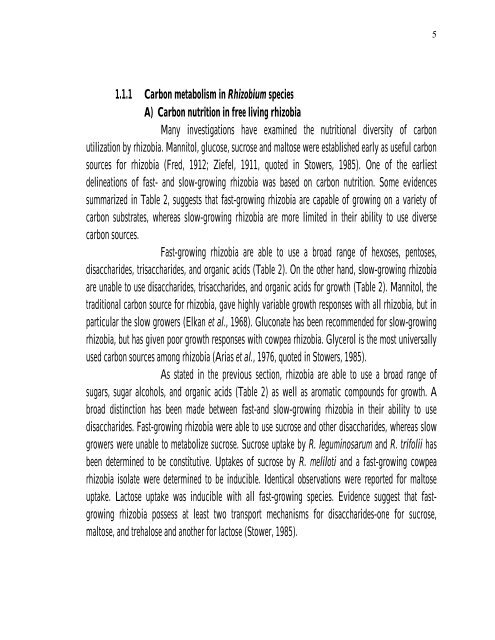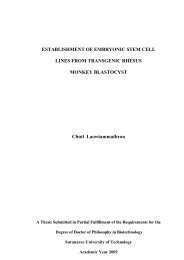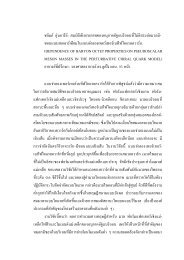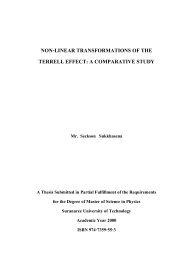PRODUCTION Of NUTRIENT SOURCES FOR RHIZOBIUM
PRODUCTION Of NUTRIENT SOURCES FOR RHIZOBIUM
PRODUCTION Of NUTRIENT SOURCES FOR RHIZOBIUM
You also want an ePaper? Increase the reach of your titles
YUMPU automatically turns print PDFs into web optimized ePapers that Google loves.
1.1.1� Carbon metabolism in Rhizobium species<br />
A) Carbon nutrition in free living rhizobia<br />
Many investigations have examined the nutritional diversity of carbon<br />
utilization by rhizobia. Mannitol, glucose, sucrose and maltose were established early as useful carbon<br />
sources for rhizobia (Fred, 1912; Ziefel, 1911, quoted in Stowers, 1985). One of the earliest<br />
delineations of fast- and slow-growing rhizobia was based on carbon nutrition. Some evidences<br />
summarized in Table 2, suggests that fast-growing rhizobia are capable of growing on a variety of<br />
carbon substrates, whereas slow-growing rhizobia are more limited in their ability to use diverse<br />
carbon sources.<br />
Fast-growing rhizobia are able to use a broad range of hexoses, pentoses,<br />
disaccharides, trisaccharides, and organic acids (Table 2). On the other hand, slow-growing rhizobia<br />
are unable to use disaccharides, trisaccharides, and organic acids for growth (Table 2). Mannitol, the<br />
traditional carbon source for rhizobia, gave highly variable growth responses with all rhizobia, but in<br />
particular the slow growers (Elkan et al., 1968). Gluconate has been recommended for slow-growing<br />
rhizobia, but has given poor growth responses with cowpea rhizobia. Glycerol is the most universally<br />
used carbon sources among rhizobia (Arias et al., 1976, quoted in Stowers, 1985).<br />
As stated in the previous section, rhizobia are able to use a broad range of<br />
sugars, sugar alcohols, and organic acids (Table 2) as well as aromatic compounds for growth. A<br />
broad distinction has been made between fast-and slow-growing rhizobia in their ability to use<br />
disaccharides. Fast-growing rhizobia were able to use sucrose and other disaccharides, whereas slow<br />
growers were unable to metabolize sucrose. Sucrose uptake by R. leguminosarum and R. trifolii has<br />
been determined to be constitutive. Uptakes of sucrose by R. meliloti and a fast-growing cowpea<br />
rhizobia isolate were determined to be inducible. Identical observations were reported for maltose<br />
uptake. Lactose uptake was inducible with all fast-growing species. Evidence suggest that fastgrowing<br />
rhizobia possess at least two transport mechanisms for disaccharides-one for sucrose,<br />
maltose, and trehalose and another for lactose (Stower, 1985).<br />
�






